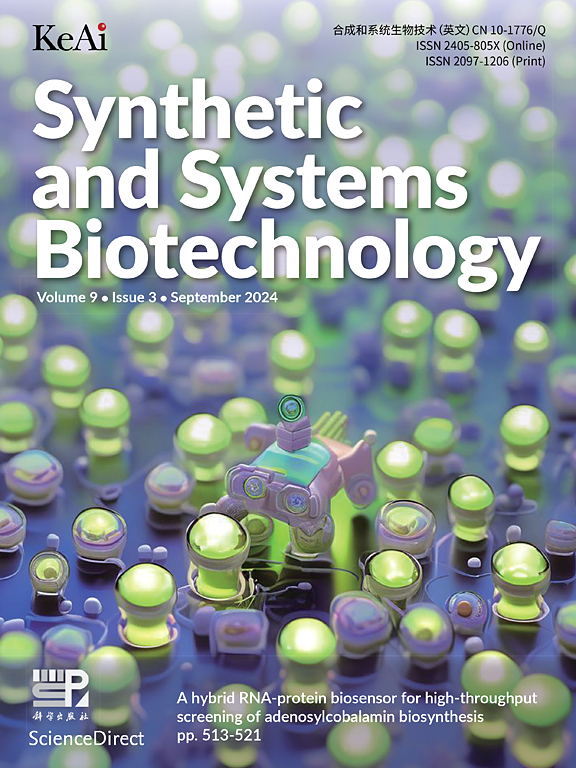纤维素产菌稻谷内生菌遗传操作合成生物学工具包的构建
IF 4.4
2区 生物学
Q1 BIOTECHNOLOGY & APPLIED MICROBIOLOGY
引用次数: 0
摘要
细菌纤维素(BC)是一种由葡萄糖聚合物组成的坚固且高度结晶的纳米材料,具有优异的保水能力,生物相容性和可定制的机械强度,使其成为先进材料应用的有前途的候选者。为了充分利用其潜力,我们开发了一个合成生物学平台,用于工程Kosakonia oryzendophytica -一种高产BC合成菌株。首先,我们系统地表征了该基架上的调控元件库(启动子、核糖体结合位点和终止子等),表明相对于典型LacO1启动子,表达强度可调,范围为1.84%至169%。随后,我们通过协调优化λ Red重组酶和Cas9核酸酶的表达,建立了高效的CRISPR/Cas9介导的无疤痕基因组编辑系统,实现了近乎完美的编辑效率(≈100%)。通过靶向敲除关键基因(bcsA, fbp和galU),该系统在功能上得到了验证,扫描电镜分析证实了ΔbcsA和Δfbp突变体中BC合成缺陷。这些遗传工具的整合——包括可调节的表达模块和精确的基因组编辑能力——提供了一个全面的工具包,用于重新编程稻瘟病菌,以生产具有定制特性的下一代基于纤维素的功能材料。本文章由计算机程序翻译,如有差异,请以英文原文为准。

Construction of a synthetic biology toolkit for the genetic manipulation in the cellulose-producing strain Kosakonia oryzendophytica
Bacterial cellulose (BC), a robust and highly crystalline nanomaterial composed of glucose polymers, exhibits exceptional properties including superior water retention capacity, biocompatibility, and customizable mechanical strength, positioning it as a promising candidate for advanced material applications. To harness its full potential, we developed a synthetic biology platform for engineering Kosakonia oryzendophytica—a hyperproductive BC synthesis strain. First, we systematically characterized a library of regulatory elements (promoters, ribosome binding sites, and terminators, etc.) in this chassis, demonstrating tunable expression intensities ranging from 1.84 % to 169 % relative to the canonical LacO1 promoter. Subsequently, we established a high-efficiency CRISPR/Cas9-mediated scarless genome editing system through coordinated optimization of λ Red recombinase and Cas9 nuclease expression, achieving near-perfect editing efficiency (≈100 %). This system was functionally validated by targeted knockout of key genes (bcsA, fbp, and galU), with scanning electron microscopy analysis confirming the BC synthesis deficiency in ΔbcsA and Δfbp mutants. The integration of these genetic tools—comprising tunable expression modules and precision genome-editing capabilities—provides a comprehensive toolkit for reprogramming K. oryzendophytica to produce next-generation cellulose-based functional materials with tailored properties.
求助全文
通过发布文献求助,成功后即可免费获取论文全文。
去求助
来源期刊

Synthetic and Systems Biotechnology
BIOTECHNOLOGY & APPLIED MICROBIOLOGY-
CiteScore
6.90
自引率
12.50%
发文量
90
审稿时长
67 days
期刊介绍:
Synthetic and Systems Biotechnology aims to promote the communication of original research in synthetic and systems biology, with strong emphasis on applications towards biotechnology. This journal is a quarterly peer-reviewed journal led by Editor-in-Chief Lixin Zhang. The journal publishes high-quality research; focusing on integrative approaches to enable the understanding and design of biological systems, and research to develop the application of systems and synthetic biology to natural systems. This journal will publish Articles, Short notes, Methods, Mini Reviews, Commentary and Conference reviews.
 求助内容:
求助内容: 应助结果提醒方式:
应助结果提醒方式:


